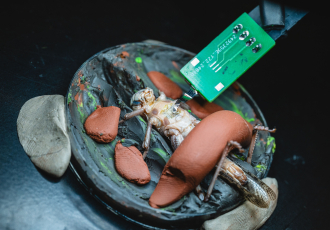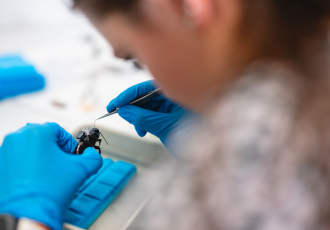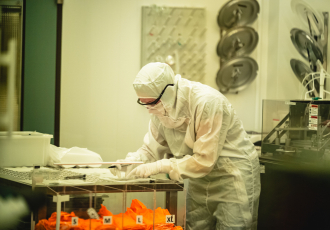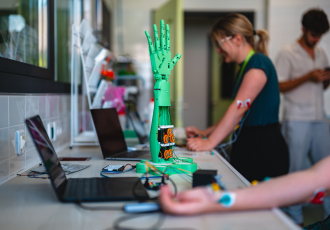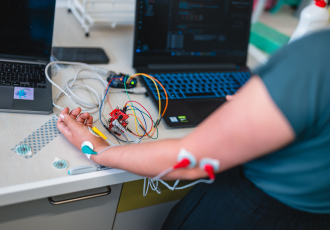3. Nov. 2025
[3 November, 2025] Scientists from CEITEC Brno University of Technology, led by Eric Daniel Glowacki, have overturned long-standing assumptions about a popular brain stimulation technique known as temporal interference stimulation. This method has promised non-invasive targeting of deep brain structures by superimposing high-frequency electric fields. Their findings, published in the prestigious Nature Communications, fundamentally reevaluate how the method works.
Electrical stimulation of the brain and peripheral nerves has progressed significantly in the past thirty years, enabling modulation of brain activity by applying small electrical signals through the skin without the need for surgery. Such stimulation is used therapeutically, and as a tool to study the functions of the brain. A promising modern version of this technique is called temporal interference stimulation. This works by applying two slightly offset high-frequency electrical signals, which oscillate thousands of times a second. When the two signals overlap in the brain, they create an “interference pattern” at a much lower frequency, which can be tuned to stimulate specific neurons – a bit like controlling the ripples that form when you drop two stones into a pond. The slow “beat” created where the signals meet was thought to stimulate neurons, while the fast waves themselves were considered invisible.
High-Frequency Signals Do the Real Work
„When I first heard about this method, it seemed like a great idea and I wanted to try it right away,“ recalls Eric Glowacki. However, the new study shows that the reality is different. Using experiments on Locusta migratoria locusts and human volunteers, the team found that both the threshold for nerve activation and the course of the stimulation response are entirely determined by the high-frequency component itself – not the slow envelope that appears where the high-frequency signals meet.
„Yes, interference stimulation works, but the mechanism is different than previously thought. Our measurements clearly showed that it is not the low-frequency envelope that stimulates. The real stimulating element is the high-frequency component itself,“ explains Eric.
The researchers compared several types of electrical signals and found they all followed the same physical model known as the Hill curve, first described in the 1930s. Their results, published under the title “The same biophysical mechanism is involved in both temporal interference and direct kHz stimulation of peripheral nerves” in Nature Communications, show that nerve cells respond directly to high-frequency currents through a process called membrane rectification, which results in electrical charge flowing in one direction more than the other. The study builds on more than half a century of work by physiologists such as Bernhard Katz and Martin Gildemeister, whose results were long forgotten by most of the community. Modern instruments and computational models have now made it possible to confirm these observations in experimental models, thereby revealing the mechanism of the popular method of interference stimulation.
Rethinking Effectiveness
This mechanism means that stimulation may occur not only in the intended target area but also along the path of the electrical field – a key limitation of the method. “Our work reveals a mechanism that has been overlooked until now. We have shown that the method can work, but it has a fundamental limitation: in addition to the target structure, it can also stimulate other areas of the brain through which the wave passes. It is therefore necessary to carefully reevaluate the interpretation of the results obtained so far,” adds Eric Glowacki.
Despite these findings, the method still holds great therapeutic promise. Understanding its true mechanism will help researchers fine-tune it for safer and more effective use in neuromodulation, rehabilitation, and bioelectronic medicine – for example, for the treatment of Parkinson’s disease.
“In neuroscience, it is easy to succumb to the illusion that new technologies bring completely new mechanisms. Our work shows that all one needs to do is to return to the physical basics,” concludes Eric.
About Bioelectronics Materials and Devices research group and CEITEC BUT
Professor Eric Daniel Glowacki’s team is part of CEITEC Brno University of Technology (CEITEC BUT). They focus on bioelectronics research and the development of technologies that use electrical and light signals to influence the nervous system. The goal is to develop new methods of neuromodulation that could contribute to the treatment of neurological diseases in the future, for example, through wirelessly powered implants.
The Bioelectronics Materials and Devices group combines knowledge from physics, chemistry, engineering, and neuroscience and is known for its pioneering use of semiconductors and bioelectronic devices in biological environments. Its work is regularly published in international scientific journals and has received support from major European grants and through collaboration with the private sector.
CEITEC BUT is an international research center that brings together experts in the fields of materials engineering, nanotechnology, biomedicine, and cybernetics. Thanks to its state-of-the-art laboratories and close cooperation with universities and industrial partners from around the world, it offers an ideal environment for the creation of new technologies with direct benefits for society.


 Share
Share
